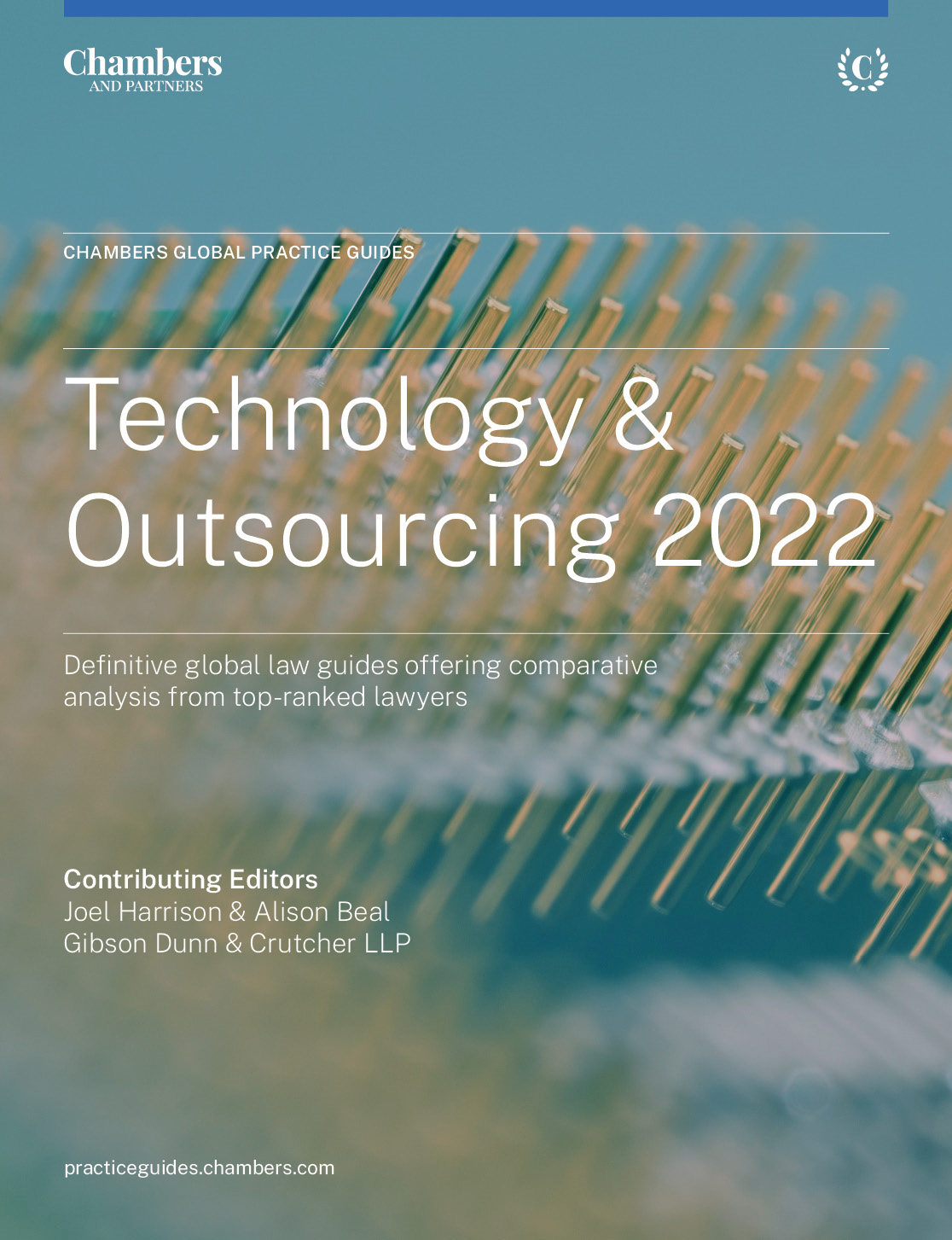
Technology & Outsourcing 2022
The new Technology & Outsourcing 2022 guide covers eight jurisdictions. The guide provides the latest legal information on IT outsourcing; business process outsourcing; legal and regulatory restrictions on outsourcing; industry-specific restrictions; legal or regulatory restrictions on data processing or data security; contract models; contract terms, including customer protections and liability; HR issues; and asset transfer terms.
Last Updated: October 27, 2022
Compare law and practice by selecting locations and topic(s)
Select Locations

Select Topic(s)

Please select at least one location and one topic to use the compare functionality.
An Introduction to Technology and Outsourcing
Digitalisation and disruptive technologies continue to evolve and grow rapidly, and companies are adopting a number of different collaboration and commercial models to develop and deploy these technologies. As a result, advisers in this area need to address an array of new and complex issues in areas such as intellectual property, data protection and cybersecurity, and financial services regulation, often in a cross-border context. As if that weren’t enough, the regulatory environment is constantly evolving, with proposed laws relating to areas such as AI and crypto-assets being put forward on a seemingly endless basis. Against this backdrop, sanctions – notably those against Russia – continue to have a significant impact on the technology market.
The global outsourcing market has undergone a number of significant changes in response to these developments, but has continued to perform strongly and has shown considerable flexibility in adapting to new technologies. In part, this simply reflects the underlying strength of the core outsourcing model, based on cost savings, access to specialist supplier expertise and service transformation. At the same time, outsourcing providers have adapted to the new technology environment to enhance the value they can provide, and in fact, outsourcing has become one of the main routes to access and implement a range of disruptive technology changes (including, most notably, cloud, AI, blockchain and smart contracts). These developments have led to a number of significant changes to the traditional outsourcing contracting model. For some time, customers and suppliers have been concerned by the essentially adversarial nature of the traditional outsourcing contractual model but have been reluctant to modify their approach in any significant way. This is now changing as the implementation of new technologies, as part of either IT or business process outsourcing, requires the parties to introduce new, specific contract provisions and protections and this has encouraged a shift to a more flexible and balanced incentive-based contract model. Ironically, it is precisely this shift which a number of advisers have been advocating for all outsourcing transactions, to help manage risk and deliver value, but it is only now, perhaps as a result of greater receptiveness to new business models for innovation and transformation, that this new approach is becoming more widely adopted.
Disruptive Technologies
Cloud services
The adoption of cloud services led to a significant change in contracting models and terms as suppliers sought to contract on their standard terms (much like COTS licences). For public cloud services, this clearly makes sense, as the risk profile, cost and operational management of public cloud services is quite different from traditional infrastructure services.
As these services have matured, and as the market has become more competitive, customers have been able to negotiate improved positions on some of the most significant terms, including liability, termination and exit support. What is clear is that these negotiations have thus far been focused on a small group of key issues to the benefit of both supplier and customer, although the scope of negotiated terms is expanding as regulators focused on data protection and cybersecurity are becoming less accepting of cloud service providers’ traditional resistance to transparency and risk-sharing on those issues.
It should be noted that the argument for accepting standard supplier terms is much weaker in relation to private cloud services (and, in some cases, hybrid cloud services) where the operational model and approach is much closer to a traditional outsourcing deal.
Agile development
The agile methodology, with its iterative and collaborative approach, has a number of clear benefits for software development and has been widely adopted by software companies and in-house project teams. As a result of its success, many companies also want to base any outsourced software development on this approach. But, in order to do so, they need to make a significant change to the traditional contract model, based as it is on closely defined requirements and specific remedies for non-performance.
The Agile Manifesto quite rightly states that “working software over comprehensive documentation” and “customer collaboration over contract negotiation” are valued, but customers are, understandably, looking for more than just a time and materials relationship which leaves all of the risk with the customer. The most successful models have addressed these concerns by combining new pricing approaches (story point billing and target cost models) with a more flexible and incentive-based contract.
AI and robotics
Innovations in AI and robotics are the next major disruptive change. AI and data-driven technology transactions need to be structured in light of emerging AI-specific laws as well as evolving laws globally in areas such as data protection and financial services regulation. Applications in specific industry sectors, such as healthcare and medicine, require specialists to consider regulatory issues in light of these technologies. AI and robotics are also having a significant impact on several key aspects of the outsourcing relationship, including:
- scope (with a greater focus on input requirements rather than output-based services);
- charges;
- change management;
- IP ownership and data management (how to avoid IP leakage);
- liability; and
- exit arrangements.
While the full impact of these changes is undoubtedly still to be felt, it is critical that companies consider these developments now and that, even in cases where they are not part of the "day 1" services, new contracts have sufficient flexibility to address these changes as they arise.
Blockchain and smart contracts
A greater adoption of blockchain and smart contracts for a range of middle and back office operations is expected over the next few years. This raises a wide range of regulatory issues and will also require significant changes to business process outsourcing (BPO) contracts, which will need to cover (among other things) the criteria for when smart contracts may be used, service levels and performance obligations, charges, change (how to deal with a change in terms to smart contracts that are by definition immutable, remains a significant issue), IP, audit and reporting, confidentiality, liability, termination (in particular, around frustration if it becomes impossible to perform the contract), and exit.
The Development of a New Contract Model
New technologies, and the adoption of new technology solutions as part of outsourcing for IT and BPO services has forced both suppliers and customers to address concerns about traditional contractual models with far greater urgency, encouraging the development of a more flexible and balanced incentive-based contract model. This new model involves much greater emphasis on:
- incentivising performance;
- remedies that are operationally focused; and
- more effective alignment of the commercial interests of both parties.
This new contract model is clearly deal-specific and depends on the nature of the services involved and the relationship of the parties. It cannot be applied in a standardised or prescriptive way and its adoption and implementation will vary across international markets, but there are some key common features.
Flexibility
This is necessary so that the service can manage the increase in range and scope of change, particularly with the implementation of agile software development and the implementation of the new disruptive technologies discussed above.
Operational remedies
There is a growing recognition that remedies should focus on operational matters and service recovery, with a “fix first” approach to fixing issues at an early stage, rather than the more traditional commercial and legal remedies which, while important in termination scenarios, are rarely used in practice.
Inter-supplier co-operation
As customers work with an increasing number of technologies and strategic suppliers, co-ordination between suppliers (and not just between the customer and each of its suppliers) becomes increasingly important and should be contemplated in service agreements.
Incentives
Customers are increasingly looking at ways to incentivise good performance rather than protecting against non-performance – shifting the balance to the carrot, rather than the stick. The best incentives are, of course, financial (eg, potential new business opportunities for the supplier and margin-sharing on projects) and these work particularly well in a multi-sourcing environment. At the same time, the parties must be careful that these incentives are not over-relied on by the customer or exploited by the supplier, and that they do align the parties’ interests properly.
Taken together, all of these developments are encouraging and suggest that the global outsourcing market will continue to flourish, with a more balanced and flexible contract model which, in itself, should enhance the overall performance and value delivered through outsourcing.
Cybersecurity Concerns
In the cybersecurity arena, the seemingly never-ending wave of supply chain attacks has led customers to reassess their technology and outsourcing relationships, and to see their vendors as a potential source of exposure. (Of course, it remains the case that outsourcing, properly implemented, can often be a route to reducing exposure, by providing customers with access to new technologies and a deeper pool of expertise.) These developments, coinciding with increased regulatory scrutiny and the rise of group litigation in data breach cases, have led – perhaps inevitably – to customers seeking to impose more onerous obligations and liability provisions on vendors. While it remains to be seen where the market will settle on these issues, one thing is clear: this will continue to be a heavily negotiated area for some time to come.

